| Construction Rating: | starstarstarstarstar_border |
| Flight Rating: | starstarstarstarstar |
| Overall Rating: | starstarstarstarstar_border |
| Manufacturer: | InFlight Rockets  |
 Brief:
Brief:
This is a skill level 2, parachute recovery, 24mm motor scale rocket. Back when I was in engineering school, I was
told that if you really wanted to test something out, abuse it in every way possible and see how well it fares. You
learn the weak points that way. The folks at InFlight Rocketry®
must have much the same general philosophy because I was contacted a few weeks ago and asked if I would be willing to
test out one of their new rockets. Word must have reached them from SHE WHO MUST BE OBEYED that if you want something
to really be messed up, Ol' John's just the guy who can do it. They must have great confidence in their product because
they have trusted it to my ham handed efforts.
The Nike Smoke arrived quite quickly. It was well packaged for protection and, upon opening the box, I found a nice looking plastic package with an attractive face card and what looked to be good quality components. I was ready to get started right away but life had other ideas. I didn't want to give it a half effort so I saved it until I could get through the most recent pressures at work and in my family life. All the while, the poor little thing sat on my desk, begging me to come out and play.
Construction:
I opened up the package to find that various component groups were sealed into their own little sub-packages. I liked
that and it helps to keep things organized. In addition to the instruction sheet and copy of the NAR code, the packaged
contained the following:

- A beautifully turned balsa nose cone
- BT 60 body tube
- BT 50 motor tube
- (2) centering rings
- Eye screw
- Engine hook
- 36" length of Kevlar®
- 18" parachute kit that seems to be a Themal Rider from Hartle Engineering
- 3/16" x 2" launch lug
- Engine block
- 1/4" x 24" elastic shock cord
- (4) laser cut balsa fins
- #5 barrel swivel and snap
- 1/8" x 1/6" x 2" balsa strip
- Waterslide decal sheet
- Patterns are printed in the instruction manual
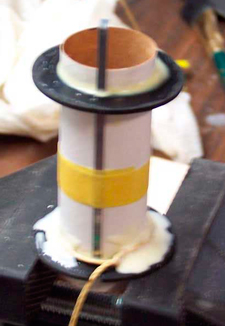 Construction begins with the motor mount. A section of BT50 was marked
1/8" from each end. A slit was cut at the forward mark to accomdate the engine hook which was then inserted.
Masking tape was used to wrap the tube at the centerline and hold the hook in place.
Construction begins with the motor mount. A section of BT50 was marked
1/8" from each end. A slit was cut at the forward mark to accomdate the engine hook which was then inserted.
Masking tape was used to wrap the tube at the centerline and hold the hook in place.
Placing the engine hood did not seem to have caused too much harm so I pressed on with the centering rings. There are two and they differ from each other. The aft one has a notch for the engine hook cut into the inner edge. The forward one has a notch through which to pass the Kevlar® shock cord on the outer edge.
Both rings fit perfectly within the main BT and around the motor mount. No sanding was needed. I slipped them both into place at the marks made in the first step and glued them with yellow glue, filleting the forward edges of each. I will come back and fillet the after edges when the glue has a chance to set up.
I also took this opportunity to swab the forward end of the mount with glue and insert the thrust ring/motor block. Again, it was a perfect fit and no modification was needed.
 The next step in the instruction is to fit the eye screw
into the nose cone. The screw was well sized and heavy enough to make me comfortable. I dislike tiny ones. I screwed it
in and then removed it. I put a dollop of glue into the hole and then screwed the eye back in and left it sitting
upright to dry.
The next step in the instruction is to fit the eye screw
into the nose cone. The screw was well sized and heavy enough to make me comfortable. I dislike tiny ones. I screwed it
in and then removed it. I put a dollop of glue into the hole and then screwed the eye back in and left it sitting
upright to dry.
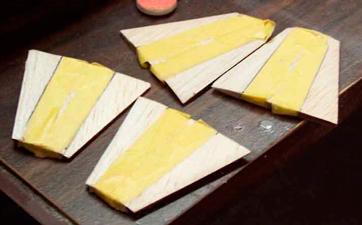 The fins for the Nike Smoke come precut. There is no need to punch them out.
Only a little sanding is needed to ready them for attachement, unless you want to give them a scale like profile. I was
planning on using this rocket as my first forray into a sport scale competition. As such, I decided to use the optional
instructions and attempt to sand the profile. Oops. I marked the root edge 5/8" from either side and the outer
edge 1/8" from either side. I then applied tape as a straightedge from the the root to the outer edges, top and
bottom, both sides. I was counting on the tape to keep me honest and my lines straight. What I should have counted on
was my inability to judge "straight" and my inherent laziness to subject me to problems of my own making.
The fins for the Nike Smoke come precut. There is no need to punch them out.
Only a little sanding is needed to ready them for attachement, unless you want to give them a scale like profile. I was
planning on using this rocket as my first forray into a sport scale competition. As such, I decided to use the optional
instructions and attempt to sand the profile. Oops. I marked the root edge 5/8" from either side and the outer
edge 1/8" from either side. I then applied tape as a straightedge from the the root to the outer edges, top and
bottom, both sides. I was counting on the tape to keep me honest and my lines straight. What I should have counted on
was my inability to judge "straight" and my inherent laziness to subject me to problems of my own making.
Not wanting to spend the rest of August sanding, I thought I would use the belt on my bench sander. After all, I just had to hold the fin straight and let it remove a little bit of material in a wedge shape up to the tape. Therein lies the problem. I held it neither straight nor did I remove a "little" material. I came very close to butchering the first fin beyond repair before it sunk in that this was what we in Texas call a BAD IDEA.
Plan B involved using a sanding stick. At least I would be removing so little material that any bias to one side or another would be visible long before it became a problem. I can be such an ignorant optimist at times. On the second stroke, I learned that I had removed way too much material under plan a and shredded the edge of the fin beyond recognition. It seemed to disolve into sawdust and fine chips.
LET ME MAKE CLEAR THAT THIS HAS NOTHING TO DO WITH THE KIT. I messed it up personally.
Putting all that effort into messing up the fins gave the original fillets on the motor mount a chance to dry so I flipped it and filleted the other side. When that had set up, I used a timber hitch to fasten a Kevlar® loop around the motor mount and re-filleted above the Kevlar® to lock it into place.
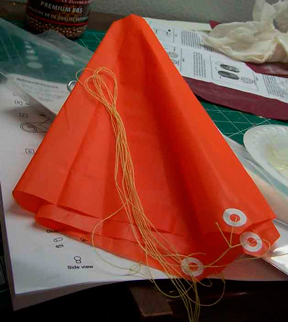 Not having anything further to do, I decided to put
the 18" parachute together. Normally, I would have discarded any plastic parachute kit but I did not do so for 2
reasons. I am trying to build this stock, as the buyer would be expected to do and it comes stock with a plastic
parachute.
Not having anything further to do, I decided to put
the 18" parachute together. Normally, I would have discarded any plastic parachute kit but I did not do so for 2
reasons. I am trying to build this stock, as the buyer would be expected to do and it comes stock with a plastic
parachute.
The other reason I am using the stock chute is that my suspicion was confirmed when I opened the parachute kit. It is a Thermal Rider from Hartle Engineering®. I have reason to know that they are different from most plastic chutes in their durability and ease of assembly. I'm still too lazy to like doing this but this chute makes it a much less onerous chore.
When the fillets on the motor mount had set up, it was time to insert the mount into the BT. I test fitted it first and found again that the fit was perfect. No sanding was needed. I used a long swab to pur a ring of glue around the circumference and slid the mount in until the end of the motor tube was even with the end of the BT. I then filleted it with glue.
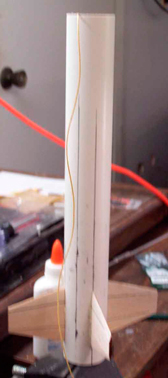 InFlight®
was very accomdating and understanding and sent my a set of replacement fins. While I was waiting for them to arrive, I
experimented with the remaining 3 from the original kit. I tried a variety of methods including setting up jigs,
counting strokes and daring my stepson to do a better job. In the end, I suppose the results are a combination of all
the above (except the stepson). I did use the tape as a stop guide but it ultimately came down to a sanding stick and
the eyeball.
InFlight®
was very accomdating and understanding and sent my a set of replacement fins. While I was waiting for them to arrive, I
experimented with the remaining 3 from the original kit. I tried a variety of methods including setting up jigs,
counting strokes and daring my stepson to do a better job. In the end, I suppose the results are a combination of all
the above (except the stepson). I did use the tape as a stop guide but it ultimately came down to a sanding stick and
the eyeball.
The kit comes with a wrap around marking guide for the fins and launch lug. I cut it out, wrapped it around and found it to be a perfect fit. I proceeded to mark the fin and lug lines and something seemed not quite right. I looked at the instructions again and they clearly indicated that the lug line should be aligned with the engine hook. I had seen that but forgot about it. I untaped and re-did the marks, producing what I like to call the inkblot camo pattern. The lines were extended in a door frame and the fin lines were given another mark 11/16" forward of the end.
In stead of doing the lazy man's CA approach to attaching the fins, I used a double glue joint using yellow glue. I applied a bit to the root edge, pressed the fin in place and then immediately removed it. I let it almost dry and then added a touch more glue and pressed it into place. Doing so produced good results and it did not take anywhere as long as I remember it taking.
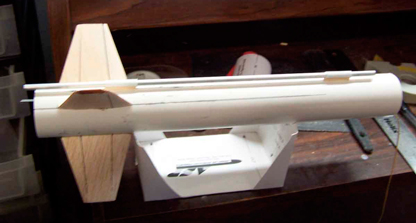 When the fins had stiffened up, I laid the rocket in a cradle
and began to apply fillets to them. While the first pair were drying, I cut the launch lug and the lug standoff in half
and glued a piece of lug to each standoff. When I rotated the rocket for the next pair of fillets, I used a length of
rod to hold the lugs straight and glued them into place on the BT.
When the fins had stiffened up, I laid the rocket in a cradle
and began to apply fillets to them. While the first pair were drying, I cut the launch lug and the lug standoff in half
and glued a piece of lug to each standoff. When I rotated the rocket for the next pair of fillets, I used a length of
rod to hold the lugs straight and glued them into place on the BT.
With that, there was not much left to construction. I tied the elastic on to the Kevlar®
and to the nosecone. I slipped the snap swivel onto the elastic, attached the chute and stuffed it in the BT. I then
put the cone in place and admired it. Not too bad, even after I had wreaked havoc upon it.
PROs: good looking kit that can be well executed even by a dunce like me
CONs: beveling the fins can require effort and teeth gnashing but that does not detract from the kit. It is just a fact of life.
 Finishing:
Finishing:
Finishing began with a coating of Elmer's Carpenter's Wood Filler®.
I brushed down the fins and the nosecone and let it dry. I decided to reserve judgement on spiral filling until the
next coating of sealer so I can see if the spirals are worth the effort.
When I sanded off the filler, I used a fairly aggresive paper, #180, I think. I knew right away that I would be putting another coat on and that one will come off with a finer paper. Let me hasten to add, this is not a reflection on the quality of the balsa. Far from it.
The beauty of the NC was readily apparent right from the first. After the first sanding, it was only more so. I resolved at that point to go whole hog and fill the spirals as well. I mixed up another batch of filler, fairly thin this time, and applied it to the NC, fins and to the spirals. The result is a goopy mess and lots of drops on my overalls but I think the rocket is going to look good.
The filler had a couple of days to dry and I began sanding again. This time was with 400# and the finish is smooth. I used a large but soft paintbrush to remove all the dust and set it up on my lazy susan for priming.
 Without thinking, I grabbed an 18mm casing to hold the
rocket. When I went to insert it, I thought, "Wow!. I forgot about that. This thing is going to scream on a 24mm.
I hope I get it back."
Without thinking, I grabbed an 18mm casing to hold the
rocket. When I went to insert it, I thought, "Wow!. I forgot about that. This thing is going to scream on a 24mm.
I hope I get it back."
So I grabbed a 24mm casing and set it up. I then began the priming process with Kilz®. I recently read a suggestion on a TRF thread that when using Kilz®, you should wait at least 24 hours to sand, even though it is dry to the touch in just a few minutes. It also recomended allowing at least that amount of time between lighter sandings to allow the newly exposed "Kilz®" to dry out a bit. Based upon my past experience, that is probably a good idea. I decided to try it on this rocket since I want it to come out perfect.
The extended wait to sand the Kilz® paid off. The sanding with #320 went well and examination showed that no more priming would be needed. Thus it was time to paint the white.
I gave the rocket an thorough but not too heavy coating of white paint. About an hour later, I gave it another coat. I could see there would be placed that would need sanding but it was looking good so far.
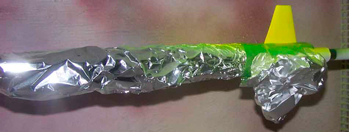 The white came out looking pretty good. I used some #400
sandpaper to erase a couple of rough spots and it still looked pretty good. That being the case, I masked for the
yellow fin.
The white came out looking pretty good. I used some #400
sandpaper to erase a couple of rough spots and it still looked pretty good. That being the case, I masked for the
yellow fin.
I used Rustoleum® flourecent yellow. I did not like the looks after the first coat, it had a "dayglo" look to it but I kept going. With successive coats, the color got richer and more natural looking.
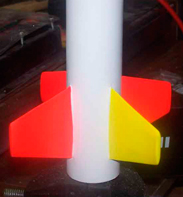 Masking for the red fins was a bit more tedious but not
difficult. When all was in place I used a scrap of balsa to press down all the edges of the Frog tape, set the rocket
up in the booth and started spraying the fourecent red. I gave everything a coat and then reapplied in about a half
hour.
Masking for the red fins was a bit more tedious but not
difficult. When all was in place I used a scrap of balsa to press down all the edges of the Frog tape, set the rocket
up in the booth and started spraying the fourecent red. I gave everything a coat and then reapplied in about a half
hour.
When the tape came off, it looked good. I was very happy. Now to the decals.
The decals are simple. The consist of 2 "United States", 2 cradles and 3 hatch covers. Even so, I managed to mess them up.
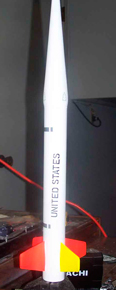 Part of this was my lack of clear thinking in preparation. I
looked at the photo in the instructions and oriented my rocket the same way. I then applied the first "United
States". I waited a while, rotated it 180 degrees and applied the other one. I applied it in the wrong direction.
If the rocket is sitting in the cradle, the text should appear right side up; one of mine is upside down.
Part of this was my lack of clear thinking in preparation. I
looked at the photo in the instructions and oriented my rocket the same way. I then applied the first "United
States". I waited a while, rotated it 180 degrees and applied the other one. I applied it in the wrong direction.
If the rocket is sitting in the cradle, the text should appear right side up; one of mine is upside down.
I also realized that I had not chosen the orientation of the yellow fin properly. As a result, the launch lugs are visible from a direction I would rather they were not. I pressed on, however and applied the cradles. One of them is a bit out of line even though I could swear that it looked right when I was placing it. By the time I noticed, though, it had already gripped.
The last of the decals were the hatch covers on the nose cone. They went on without any problem.
Construction Rating: 4 out of 5
 Flight:
Flight:
It took a long time between completion of the build and an opportunity to fly but the wait was worth it. The rocket
was entered as part of an informal sport scale competition at my NAR monthly launch. It got good marks in the static
judging but then I had to prove it worked. I loaded it up with a C11-5 and set it on the pad. When my turn came, it
boosted straight and true to an extremely high altitude; I could barely see it. The chute deployed and I realized that
I was going to have a ways to walk. Fortunately, an excited young girl was eager to do my walking for me and the rocket
came back without any damage. When it came back, one of the other competitors was amazed to see that the nosecone was
of balsa.
My original intent was to try a D12-7 next but I thought better of it based upon the performance with the C. I decided to try a newly made 18mm adapter and loaded a C6-3. If anything, this flight was even better than the last and the drift was correspondingly far. It became a rocket to be picked up when we drove away. Again, there was no damage.
PROs: great performerRecovery:
CONs: can be easily lost because it is a GREAT performer.
I used the stock chute. In the future, I am either going to switch it out for a smaller one or cut a spill hole. In any event, the provided chute protects the rocket well and provides a decent cardiovascular workout.
Summary:
This is a great rocket in terms of construction, flight and finished appearance. It takes a little patience to get it
right but the patience is well rewarded.
Overall Rating: 4 out of 5
 |
 |
Flights
 |
 |